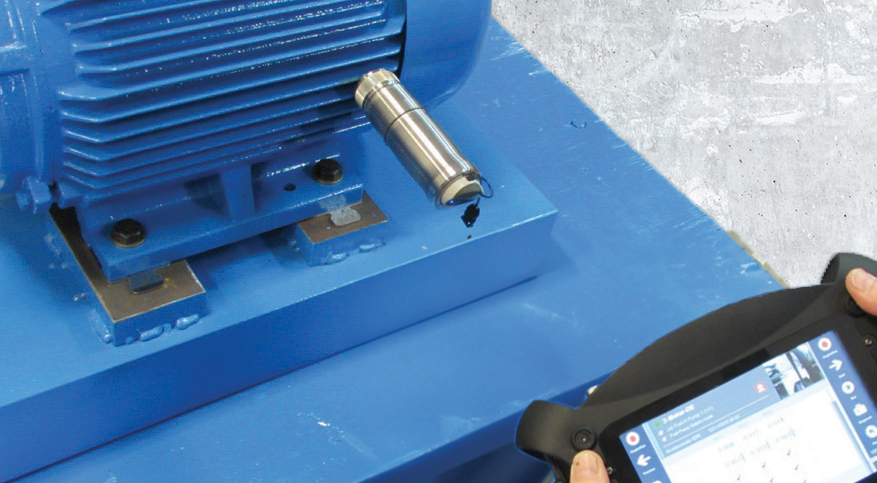Understanding Compressor Vibration
Does your compressor vibrate? BlowVac Systems delves into specific compressor vibration behaviour. Find out all you need to know about compressors & vibration.
request quoteDoes your compressor vibrate? BlowVac Systems delves into specific compressor vibration behaviour. Find out all you need to know about compressors & vibration.
request quote

Vibration is an inherent characteristic of compressors, and it is worth noting that distinct compressor types exhibit their individualized vibration signatures. BlowVac Systems delves into the intricacies of compressor vibration, aiming to provide readers with insights into what they can anticipate concerning their specific compressor's vibrational behavior.
A straightforward and rudimentary method of vibration analysis involves placing a US nickel coin on top of your compressor's surface. If the coin rolls off, it indicates high compressor vibration—a technique aptly termed the "nickel test." While this approach may offer some utility, a more sophisticated vibration analysis methodology is explored below.
Most seasoned vibration analysts and monitoring companies employ specialized instruments like accelerometers, seismic probes, and proximity probes to measure compressor vibration. The data collected by these instruments undergoes analysis using a vibration tester/analyzer. Opting for a vibration tester/analyzer with the capability to present data in spectrum plots and time wave form plots empowers users with invaluable insights into their compressor's operational behavior.
While each compressor type exhibits its distinct vibration signature, it is noteworthy that certain vibration behaviors can be shared among them. Some prevalent causes of compressor vibration, not limited to any specific type, include:
Centrifugal compressors, also known as dynamic compressors, employ radial centrifugal action to propel the flow from the suction to the discharge of the compressor. The process involves a substantial increase in velocity, facilitated by centrifugal forces, which imparts kinetic energy. As the flow progresses towards the discharge, this kinetic energy is subsequently converted into pressure.
In comparison to the other compressor technologies discussed in this article, centrifugal compressors exhibit relatively smooth operation with generally low vibration levels. A typical vibration spectrum from a centrifugal compressor indicates the highest amplitude at 1X running speed, accompanied by smaller amplitudes occurring at multiples of 1X. Notably, if significant vibration amplitudes are detected at non-integer multiples of the running speed, it could serve as an indication of a potential issue with the compressor.
Centrifugal compressors face a distinctive challenge known as surge. Surge transpires when the compressor experiences excessive back pressure, leading to momentary flow reversal or recirculation within the compressor. As a consequence of surge, vibration amplitudes are usually generated at frequencies below the running speed (sub-synchronous frequencies). To safeguard the centrifugal compressor from potential damage, it is crucial to steer clear of surge operation or operating near surge conditions. Instead, the conditions should be promptly adjusted to prevent surge occurrences and ensure the compressor's optimal performance and longevity.
Reciprocating compressors, classified as positive displacement compressors, function similarly to car engines by utilizing pistons and cylinders to compress gas. The process involves drawing gas into the cylinder and subsequently sealing it off from the suction. As the piston moves, the volume of gas confined within the cylinder decreases, resulting in an increase in gas pressure. Finally, the cylinder opens to the compressor discharge, permitting the gas to exit the cylinder. This cyclic operation facilitates efficient gas compression within the reciprocating compressor.
Similar to a car engine, the reciprocating compressor incorporates a crankshaft and connecting rods as integral components of its operation. Depending on the specific design, reciprocating compressors may experience mass unbalance forces due to opposed reciprocating components and moment/couple forces arising from offsets of these opposed elements. These forces are inherent to the compressor's design and inevitably result in vibrations occurring at frequencies of 1X and 2X running speed. As a natural outcome of the compressor's operation, these vibrations need to be accounted for and managed to ensure optimal performance and longevity.
Another significant contributor to reciprocating compressor vibration is pressure pulsations. Each time a cylinder opens and closes, connecting to the compressor suction and discharge, a pulse of pressure is generated. In the case of single-acting cylinders, pressure pulsations occur at 1X running speed, while double-acting cylinders produce pressure pulsations at 2X running speed. These pressure pulsations can be potentially damaging, particularly to piping systems, and are typically addressed and controlled using pulsation bottles. These specialized devices play a crucial role in managing and minimizing the adverse effects of pressure pulsations, ensuring smooth and reliable compressor operation.
In the vibration spectrum of reciprocating compressors, amplitudes are typically observed at 1X running speed and its multiples, as a direct consequence of the aforementioned vibration factors. When measuring vibration in proximity to a crosshead, you can anticipate detecting impacts from valves, pulsations, and other components, which can excite resonances within the compressor's structure. As a result, amplitudes and frequencies may undergo fluctuations throughout one revolution of the compressor. In such scenarios, considering an analysis of vibration in the time domain, as opposed to a spectrum plot, might be advisable for a more comprehensive understanding.
It is worth noting that reciprocating compressors generally exhibit higher overall vibration levels compared to other types of compressors due to the intricate mechanical processes involved in their operation. Careful monitoring and analysis of vibration patterns are crucial to ensure the compressor's smooth operation, longevity, and the mitigation of potential issues that may arise over time.
Screw compressors, belonging to the category of positive displacement compressors, operate with two rotors: a male and a female rotor. In this configuration, the male rotor functions as the driving rotor and typically has fewer lobes compared to the female rotor. A common setup includes a four-lobe male rotor meshing with a six-lobe female rotor. Similar to reciprocating compressors, screw compressors compress gas by reducing the volume within the chambers formed between the rotor lobes and the walls of the compressor casing.
As the rotors rotate, the interlocking rotor lobes facilitate a gradual reduction in chamber volume, culminating in the discharge of the compressed gas. This continuous meshing of the rotors facilitates smooth and efficient gas compression, making screw compressors a favored choice in various applications where a steady and reliable flow of compressed gas is required.
If the screw compressor male rotor has a different number of lobes than the female rotor, they will have different rotational speeds. Vibration can be expected to occur at 1X the male rotor speed and 1X the female rotor speed. Using the four (4) lobe male rotor / six (6) lobe female rotor example, the female rotor speed will be 4/6 = 0.67X the male rotor speed.
Similar to reciprocating compressors, screw compressors also generate pressure pulsations as their chambers open and close during the compression process from the suction to the discharge of the compressor. These pressure pulsations often lead to compressor vibration occurring at the pulsating frequency and its multiples. In screw compressors, this frequency is commonly known as the pocket passing frequency (PPF), which equals the running speed multiplied by the number of lobes on the rotor.
Notably, for screw compressors, the male rotor speed multiplied by the number of male rotor lobes will be equal to the female rotor speed multiplied by the number of female rotor lobes, resulting in the existence of a single PPF for the compressor. Unlike reciprocating compressors, screw compressors can operate at higher speeds and produce more pressure pulsations within one revolution. Consequently, it is common to observe vibration at higher frequencies in screw compressors.
Although the vibration amplitudes in most screw compressors are not as significant as those observed in reciprocating compressors, they are generally higher compared to centrifugal compressors. In fact, the American Petroleum Institute (API) recognizes this difference, which is reflected in higher vibration design limits for screw compressors compared to centrifugal compressors. Careful monitoring and understanding of vibration behavior are crucial to ensure efficient and reliable operation of screw compressors while adhering to acceptable vibration limits.
Indeed, like reciprocating and screw compressors, liquid ring compressors are classified as positive displacement compressors. These compressors feature an eccentrically positioned impeller within the casing. The compressor is supplied with a liquid sealing fluid, which, upon rotation of the impeller, is forced towards the outer diameter of the compressor casing, forming a liquid ring.
As the impeller continues its rotation through the sealing liquid, the volume between the impeller vanes decreases due to its eccentric configuration in relation to the casing. This reduction in volume compresses the gas trapped within the impeller, resulting in the desired gas compression. Liquid ring compressors offer certain advantages in specific applications, such as their ability to handle wet or saturated gases and their suitability for tasks involving gas compression in the presence of liquids or vapors.
As with other positive displacement compressors, the liquid ring compressor exhibits pressure pulsations, resulting in compressor vibration. This vibration occurs at a frequency equal to the operating speed multiplied by the number of vanes on the impeller, commonly referred to as the vane pass frequency. Additionally, vibration amplitudes at multiples of the vane pass frequency can also be anticipated.
Cavitation is a prevalent concern with liquid ring compressors. When cavitation occurs, it tends to cause an increase in vibration at the vane pass frequency and its multiples, indicating potential issues within the compressor.
Despite these challenges, liquid ring compressors can offer advantages in terms of vibration control. The presence of the liquid ring within the compressor acts as a natural dampening mechanism for pressure pulsations, helping to maintain lower vibration levels compared to certain other types of compressors. This feature is particularly beneficial in dampening the impact of pressure pulsations, contributing to smooth and efficient compressor operation while minimizing vibration-related concerns.
Indeed, the rotary vane compressor, also known as the sliding vane compressor, is classified as a positive displacement compressor. Similar to the liquid ring compressor, the rotor in the rotary vane compressor is eccentrically positioned within the compressor casing. The rotor features slots that house the compressor vanes. As the rotor spins, centrifugal force causes the vanes to move outward from the rotor slots, enabling them to come into contact with the cylinder bore.
As the rotor continues to rotate, it pushes the vanes back into their slots, leading to a reduction in the volume contained between two vanes. This cyclic operation effectively compresses the gas trapped within the compressor, making it an efficient and reliable means of gas compression. Rotary vane compressors are utilized in various applications where a steady flow of compressed gas is required, offering advantages such as quiet operation and relatively low vibration levels.
Correct, as with other positive displacement compressors, the rotary vane compressor generates pressure pulsations. These pressure pulsations lead to vibration in the compressor. The vibration frequency in rotary vane compressors is equal to the operating speed of the compressor multiplied by the number of vanes (or blades) present in the rotor. This frequency is commonly referred to as the vane pass frequency or blade pass frequency.
Monitoring and understanding the vibration behavior at the vane pass frequency is crucial for maintaining the optimal performance and reliability of rotary vane compressors. This frequency provides valuable insights into the compressor's functioning and helps identify any potential issues related to pressure pulsations and vibration.
Vibration will also occur at multiples of the vane pass frequency. If the vibration spectrum is showing amplitudes occurring at frequencies not equal to vane pass or multiples of vane pass, this may be indicative of an issue with the compressor or system.
To effectively assess the performance of Compressors using vibration data, it is essential to measure vibration data soon after commissioning the equipment and reaching normal steady-state operating conditions. This measured vibration data can be used as a baseline for future comparisons. When evaluating vibration measurements over time, it is vital to consider not only overall vibration amplitudes but also spectrum data illustrating amplitude versus frequency.
Moreover, changes in operating conditions, such as variations in speed, pressure, and temperature, can significantly impact compressor vibration. Therefore, it is crucial to include the operating conditions as part of the vibration data to accurately analyze any changes and identify potential issues. Monitoring vibration data throughout the compressor's operational life provides valuable insights into its performance, helps detect early signs of anomalies, and allows for timely maintenance or adjustments to maintain optimal compressor performance and longevity.
Do you have questions about your compressor vibration? Would you like an in-depth vibration analysis done on your compressor?
Our sales & technical teams are ready to answer any questions regarding our re-manufactured machinery.
Contact SalesOur technicians are factory certified to perform repairs in our shop, or in the field.
Request a serviceBlowvac Systems is an authorised distributor for the following brands
Hibon, IR, Robuschi, Becker, Sigma Dynamic Transfer Case, Paragon, SuperVac trucks, Solberg Silencers, Stoddard Silencers, NVE Pumps, Namco Transfer Case, Mac Equipment, Ro-Flo Compressors, Dynablast Burners, Pratissoli Pumps, American Industrial Heat Transfer













Enquiries: +1 (905) 672-5200
WorkShop: +1 (905) 672-5206
Email: info@blowvacsystems.com
6096 Shawson Dr
Mississauga, ON L5T 1E6
Canada